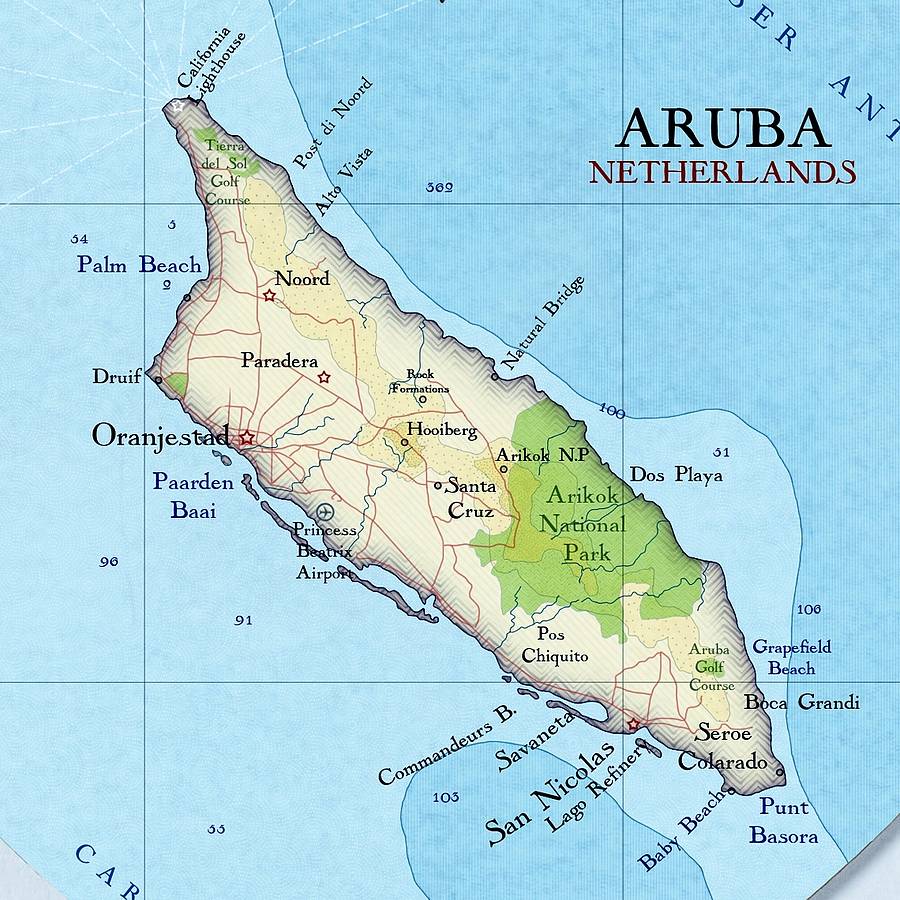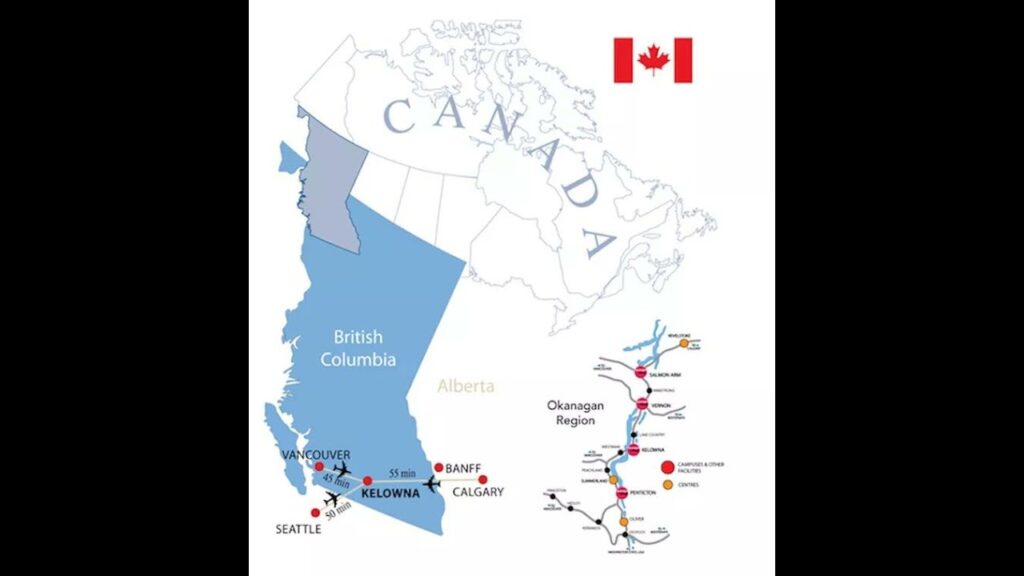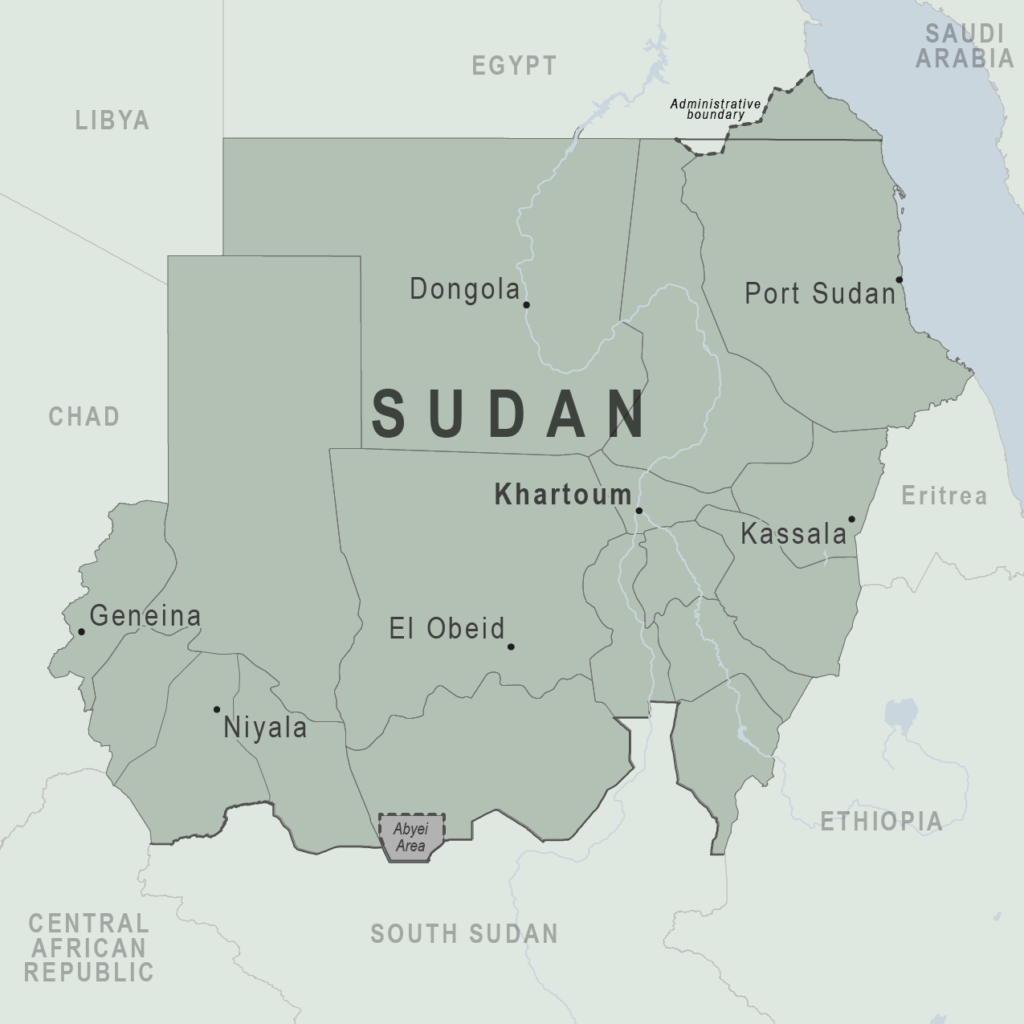Introduction
Aruba is a picturesque Caribbean island known for its stunning beaches, vibrant culture, and welcoming atmosphere. Located just off the coast of Venezuela, this island is part of the Kingdom of the Netherlands. Despite its small size, Aruba boasts a rich history, diverse geography, and a thriving tourism industry. This comprehensive guide will explore the island’s maps, geographical features, political structure, demographics, economy, culture, and more.
Geographic Overview
Location and Size
Aruba is situated in the southern Caribbean Sea, approximately 29 kilometers (18 miles) north of the coast of Venezuela. It is part of the Lesser Antilles island group and is one of the four constituent countries that form the Kingdom of the Netherlands. Aruba covers an area of about 180 square kilometers (69 square miles), making it one of the smaller islands in the Caribbean.
Topography
Aruba’s topography is relatively flat compared to other Caribbean islands, with its highest point being Mount Jamanota at 188 meters (617 feet) above sea level. The island is characterized by its arid landscape, rocky coastlines, and sandy beaches. The interior of Aruba features a unique desert-like terrain with cacti, divi-divi trees, and aloe vera plants.
The island’s western and southern coasts are known for their pristine white-sand beaches and calm turquoise waters, while the northern and eastern coasts are rugged and less developed, with dramatic cliffs and rough seas.
Climate
Aruba enjoys a tropical semi-arid climate, with consistent warm temperatures year-round and low rainfall. The average temperature ranges between 26°C (79°F) and 32°C (90°F). The island lies outside the hurricane belt, making it a popular destination throughout the year. The trade winds that blow from the northeast help to moderate the temperature and provide a pleasant cooling effect.
Natural Features
Aruba’s natural features include stunning beaches, unique rock formations, and diverse marine life. Some of the most notable natural attractions are:
- Arikok National Park: Covering nearly 20% of the island, this park is home to a variety of wildlife, hiking trails, and historical sites.
- Natural Pool (Conchi): A secluded natural rock pool located within Arikok National Park, perfect for swimming and snorkeling.
- California Lighthouse: Situated on the northern tip of the island, offering panoramic views of the coastline and surrounding areas.
- Hooiberg: A volcanic formation in the center of the island, offering a challenging hike and rewarding views from the top.
Political Structure
Government
Aruba is a constituent country within the Kingdom of the Netherlands, which means it has a degree of autonomy but remains under the sovereignty of the Dutch Crown. The island has its own parliament, the Staten van Aruba, which consists of 21 members elected for a four-year term. The head of government is the Prime Minister, while the Governor represents the Dutch monarch.
Administrative Divisions
Aruba is divided into eight regions (districts) for administrative purposes:
- Noord
- Oranjestad West
- Oranjestad Oost
- Paradera
- San Nicolas Noord
- San Nicolas Zuid
- Santa Cruz
- Savaneta
These regions help manage local governance and public services, ensuring that residents and visitors receive the necessary support and resources.
Demographics
Population
As of 2023, Aruba has an estimated population of approximately 110,000 people. The population is diverse, with a mix of ethnic backgrounds, including people of African, European, and indigenous descent. The island’s welcoming atmosphere and high quality of life make it an attractive destination for both residents and expatriates.
Language
The official languages of Aruba are Dutch and Papiamento. Papiamento is a Creole language that evolved from a mix of African, Portuguese, Spanish, Dutch, and Arawak languages. It is widely spoken by the local population. English and Spanish are also commonly spoken due to the island’s tourism industry and international connections.
Religion
Aruba is predominantly Christian, with Roman Catholicism being the largest denomination. Other Christian denominations, such as Protestantism and Jehovah’s Witnesses, are also present. Additionally, there are smaller communities of Jews, Muslims, Hindus, and Buddhists, reflecting the island’s cultural diversity.
Urbanization
Aruba’s population is primarily concentrated in urban areas, with the capital city, Oranjestad, being the largest and most developed urban center. Other significant towns include San Nicolas, Noord, and Santa Cruz. These towns offer a range of amenities and services, contributing to the island’s overall quality of life.
Economy
Overview
Aruba’s economy is largely driven by tourism, which accounts for a significant portion of the island’s GDP. The service sector, including hospitality, retail, and financial services, is the backbone of the economy. In addition to tourism, Aruba’s economy benefits from oil refining, aloe production, and limited agriculture and manufacturing.
Key Industries
Tourism
Tourism is the lifeblood of Aruba’s economy, attracting over a million visitors annually. The island’s pristine beaches, luxurious resorts, and vibrant culture make it a premier vacation destination. Key tourist attractions include:
- Palm Beach: Known for its high-rise hotels, restaurants, and nightlife.
- Eagle Beach: A quieter, more relaxed beach with soft white sand.
- Arikok National Park: Offering hiking, historical sites, and natural beauty.
- Oranjestad: The capital city, featuring colorful Dutch colonial architecture, shopping, and dining.
Oil Refining
The oil refining industry has played a significant role in Aruba’s economy since the early 20th century. The island’s strategic location and deep-water ports made it an ideal location for refining Venezuelan crude oil. Although the industry has faced challenges and fluctuations, it remains an important part of the economic landscape.
Aloe Production
Aruba is known for its high-quality aloe vera products, which are produced and exported worldwide. The island’s dry climate and sandy soil create ideal conditions for growing aloe vera. The Aruba Aloe Factory, established in 1890, is one of the oldest aloe companies in the world and a popular tourist attraction.
Trade
Aruba has a small but active trade sector, with imports significantly outweighing exports. The island imports a wide range of goods, including food and beverages, machinery, vehicles, and consumer products. Major trading partners include the United States, the Netherlands, and Venezuela. Exports primarily consist of refined oil products, aloe vera products, and some agricultural goods.
Economic Challenges
Despite its economic strengths, Aruba faces several challenges. The island’s heavy reliance on tourism makes it vulnerable to global economic fluctuations and events that impact travel, such as the COVID-19 pandemic. Additionally, Aruba must address issues related to environmental sustainability, waste management, and water resources to ensure long-term economic and ecological health.
Culture
Heritage and Traditions
Aruba’s culture is a vibrant blend of indigenous, African, European, and Caribbean influences. The island’s rich heritage is celebrated through music, dance, art, and festivals. Traditional Aruban music, such as tumba and tambú, features rhythmic drumming and lively melodies, reflecting the island’s African and indigenous roots.
Festivals and Celebrations
Arubans love to celebrate, and the island hosts numerous festivals and events throughout the year. Some of the most notable celebrations include:
- Carnival: Aruba’s largest and most colorful festival, featuring parades, music, dancing, and elaborate costumes. Carnival season culminates in the Grand Parade held in Oranjestad.
- Dia di Betico: Celebrated on January 25th, honoring the birthday of Betico Croes, a political leader who played a significant role in Aruba’s move towards greater autonomy.
- Aruba Hi-Winds: A major windsurfing and kitesurfing event attracting participants and spectators from around the world.
- Bon Bini Festival: A weekly event held in Oranjestad showcasing Aruban culture through music, dance, and traditional food.
Cuisine
Aruban cuisine is a delightful fusion of flavors influenced by its diverse cultural heritage. Local dishes often feature fresh seafood, tropical fruits, and locally grown produce. Some popular Aruban foods include:
- Keshi Yena: A traditional dish made with cheese stuffed with spiced meat, often served with rice and vegetables.
- Pastechi: Savory pastries filled with cheese, meat, or fish, commonly enjoyed as a snack or breakfast.
- Funchi: A cornmeal-based side dish similar to polenta, often served with stews and seafood.
- Coconut Shrimps: Breaded and fried shrimp with a coconut coating, typically served with dipping sauce.
- Aruba Ariba: A signature cocktail made with local Coecoei liquor, rum, vodka, fruit juice, and grenadine.
Arts and Crafts
Aruba’s artistic community is vibrant and diverse, with local artists drawing inspiration from the island’s natural beauty and cultural heritage. Art galleries, studios, and public art displays showcase a range of works, from traditional crafts to contemporary pieces. Visitors can find unique handmade souvenirs, such as pottery, jewelry, and textiles, reflecting the island’s creative spirit.
Tourism
Major Tourist Destinations
Palm Beach
Palm Beach is the heart of Aruba’s tourism industry, known for its high-rise hotels, luxurious resorts, and bustling nightlife. The beach itself is a beautiful stretch of soft white sand and calm, clear waters, making it ideal for swimming, sunbathing, and water sports. The area is also home to numerous restaurants, bars, and shops, providing plenty of entertainment options for visitors.
Eagle Beach
Eagle Beach is often regarded as one of the best beaches in the world, known for its wide expanse of powdery white sand and tranquil turquoise waters. Unlike Palm Beach, Eagle Beach has a more laid-back and relaxed atmosphere, making it perfect for those seeking a quieter escape. The beach is also famous for its iconic fofoti trees, which are often photographed and symbolize Aruba’s natural beauty.
Arikok National Park
Arikok National Park is a must-visit destination for nature lovers and adventure seekers. Covering nearly 20% of the island, the park offers a variety of hiking trails, caves with ancient rock drawings, unique flora and fauna, and stunning landscapes. Visitors can explore the park’s diverse ecosystems, including dry forests, sand dunes, and rocky coastlines.
Oranjestad
Oranjestad, the capital city of Aruba, is a vibrant hub of culture, history, and modern amenities. The city is known for its colorful Dutch colonial architecture, lively shopping districts, and waterfront attractions. Key sites to visit include Fort Zoutman, the oldest building on the island, and the nearby Wilhelmina Park, which offers beautiful views of the harbor.
San Nicolas
San Nicolas, located on the southeastern tip of the island, is known for its rich cultural heritage and vibrant arts scene. The town hosts the annual Aruba Art Fair, attracting artists and visitors from around the world. San Nicolas is also home to Baby Beach, a popular spot for swimming and snorkeling due to its calm, shallow waters and abundant marine life.
Ecotourism
Aruba’s commitment to sustainability and environmental conservation has made it a popular destination for ecotourism. The island’s natural attractions, such as Arikok National Park, the Bubali Bird Sanctuary, and the mangrove forests, offer opportunities for eco-friendly activities like birdwatching, hiking, and guided nature tours. Aruba’s efforts to protect its marine ecosystems also make it a prime location for responsible diving and snorkeling.
Adventure Tourism
For those seeking adventure, Aruba offers a range of thrilling activities and experiences. The island’s rugged terrain and coastal waters provide the perfect backdrop for outdoor adventures, including:
- Off-Roading: Explore Aruba’s wild side with off-road tours that take you to remote beaches, hidden caves, and dramatic landscapes.
- Windsurfing and Kitesurfing: The constant trade winds and warm waters make Aruba a top destination for windsurfing and kitesurfing, with lessons and equipment rentals available for all skill levels.
- Scuba Diving and Snorkeling: Discover Aruba’s vibrant underwater world, featuring coral reefs, shipwrecks, and diverse marine life.
- Hiking and Biking: The island’s trails and paths offer scenic routes for hiking and biking, from coastal walks to challenging mountain climbs.
Historical Background
Indigenous History
Before European contact, Aruba was inhabited by the Caquetio people, an Arawak-speaking indigenous group. The Caquetio lived in small villages, practiced agriculture, and engaged in fishing and hunting. Evidence of their presence can be found in the form of petroglyphs and rock paintings in various caves and archaeological sites across the island.
European Exploration and Colonization
Aruba was first encountered by Spanish explorers in 1499, with Alonso de Ojeda credited as the first European to visit the island. The Spanish colonized Aruba but found it unsuitable for large-scale agriculture due to its arid climate. Instead, they used the island for livestock grazing and as a strategic location in the Caribbean.
In 1636, Aruba was acquired by the Dutch West India Company, and it became part of the Dutch colonial empire. The Dutch influence is still evident today in the island’s architecture, legal system, and cultural traditions.
Modern History
Throughout the 19th and 20th centuries, Aruba experienced significant economic and social changes. The discovery of gold in the early 19th century led to a brief gold rush, followed by the establishment of the aloe vera industry. The opening of the Lago Oil Refinery in 1924 marked a turning point in Aruba’s economy, attracting workers from around the world and boosting economic growth.
In 1986, Aruba gained a separate status within the Kingdom of the Netherlands, becoming an autonomous country with its own government and administrative responsibilities. This move towards greater self-governance has allowed Aruba to develop its economy and infrastructure while maintaining close ties with the Netherlands.
Environmental Issues
Coastal Erosion and Coral Reefs
Coastal erosion and the degradation of coral reefs are significant environmental concerns in Aruba. The island’s beaches and coastal areas are vulnerable to erosion due to natural processes and human activities. Coral reefs, which provide critical habitat for marine life and protect shorelines from storm surges, are threatened by climate change, pollution, and overfishing. Efforts to protect and restore these vital ecosystems include marine protected areas, coral reef restoration projects, and sustainable tourism practices.
Water Management
Water management is a critical issue for Aruba, given its arid climate and limited freshwater resources. The island relies heavily on desalination to produce drinking water from seawater. Sustainable water use and conservation efforts are essential to ensure the long-term availability of this precious resource. Initiatives such as water-saving technologies, public awareness campaigns, and the use of reclaimed water for irrigation are important steps in addressing water management challenges.
Waste Management
Effective waste management is vital to maintaining Aruba’s environmental health and attractiveness as a tourist destination. The island faces challenges related to waste generation, disposal, and recycling. Efforts to improve waste management include promoting recycling programs, reducing plastic use, and exploring innovative waste-to-energy solutions. Community involvement and education are key components of successful waste management strategies.
Conclusion
Aruba is a unique and captivating island that offers a blend of natural beauty, rich cultural heritage, and economic vitality. Its stunning beaches, diverse ecosystems, and vibrant culture make it a sought-after destination for travelers from around the world. Understanding the island’s geography, political structure, demographics, economy, and environmental challenges provides a comprehensive view of this Caribbean gem. As Aruba continues to grow and evolve, it remains committed to preserving its natural and cultural treasures while embracing sustainable development and innovation.
What part of the map is Aruba?
Aruba is located in the southern Caribbean Sea, about 29 kilometers (18 miles) north of the coast of Venezuela. It is part of the Lesser Antilles island group.
What are the geographic features of Aruba?
Aruba features a flat and arid landscape with its highest point being Mount Jamanota at 188 meters (617 feet) above sea level. The island is characterized by sandy beaches on the western and southern coasts, and rocky coastlines on the northern and eastern coasts. Notable natural features include Arikok National Park, the Natural Pool (Conchi), and the iconic fofoti trees on Eagle Beach.
What body of water is Aruba?
Aruba is surrounded by the Caribbean Sea.
What is Aruba best known for?
Aruba is best known for its beautiful white-sand beaches, clear turquoise waters, vibrant tourism industry, and its warm, dry climate. The island is also famous for its unique cultural blend, colorful festivals, and rich history.
What is Aruba called now?
Aruba is still called “Aruba.” It is an autonomous country within the Kingdom of the Netherlands.
What is the capital of Aruba?
The capital of Aruba is Oranjestad.
What country controls Aruba?
Aruba is a constituent country of the Kingdom of the Netherlands, which means it has a degree of autonomy but is ultimately under the sovereignty of the Dutch Crown.
Who discovered Aruba?
Aruba was first encountered by Spanish explorer Alonso de Ojeda in 1499.
Is Aruba all desert?
While Aruba is not entirely desert, it has an arid, desert-like climate with a landscape that includes cacti, divi-divi trees, and rocky terrains. However, it also features lush areas, particularly within Arikok National Park, and beautiful coastal regions with sandy beaches.
What is the name of the sea in Aruba?
The sea surrounding Aruba is the Caribbean Sea.
Is Aruba its own continent?
No, Aruba is not its own continent. It is an island in the Caribbean Sea and part of the continent of South America, geographically. Politically, it is an autonomous country within the Kingdom of the Netherlands.
- Animals That Live In The Tundra - September 1, 2024
- Animals That Live In Madagascar - September 1, 2024
- 10 Largest Cities In Hawaii - September 1, 2024




